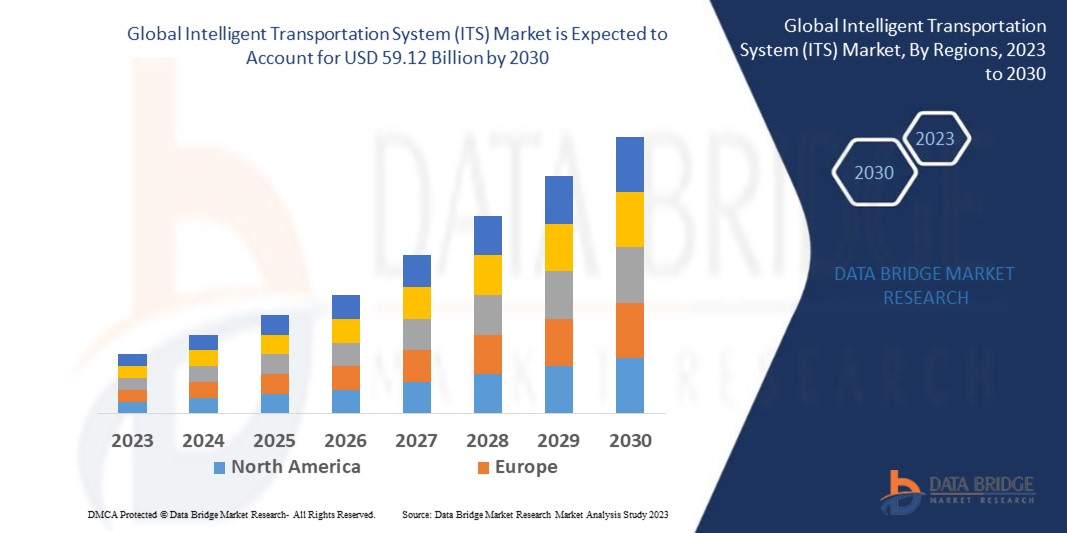Transforming Global Mobility: The Rise of the Intelligent Transportation System (ITS) Market
Global Intelligent Transportation System (ITS) Market – Industry Trends and Forecast to 2030
https://www.databridgemarketresearch.com/reports/global-intelligent-transportation-system-its-market
Data Bridge Market Research analyses that the intelligent transportation system (ITS) market, valued at USD 28.25 billion in 2022, will reach USD 59.12 billion by 2030, growing at a CAGR of 9.67% during the forecast period of 2023 to 2030

The global Intelligent Transportation System (ITS) market is undergoing a rapid transformation driven by technological innovation, urbanization, and the growing need for efficient, safe, and sustainable mobility solutions. ITS integrates advanced communication, information, and sensor technologies into transportation networks, enabling smarter management of traffic, logistics, and public transit systems. This market has become a cornerstone of modern infrastructure, enhancing safety, reducing congestion, minimizing environmental impact, and improving user experience in both urban and interurban transportation.
Understanding Intelligent Transportation Systems
Intelligent Transportation Systems refer to the application of modern technologies such as the Internet of Things (IoT), artificial intelligence (AI), machine learning (ML), big data analytics, and cloud computing to manage and optimize transportation networks. These systems encompass a wide range of applications, including traffic management, public transport monitoring, fleet management, electronic toll collection, parking management, and traveler information systems.
By integrating these technologies, ITS facilitates real-time data collection, processing, and dissemination, allowing authorities and users to make informed decisions. Whether it’s managing urban traffic flow through adaptive signal control, preventing accidents through vehicle-to-everything (V2X) communication, or enhancing logistics through route optimization, ITS contributes significantly to creating smarter and safer mobility ecosystems.
Market Dynamics
The demand for ITS is being propelled by multiple interrelated factors. Rapid urbanization has led to traffic congestion and pollution challenges, particularly in megacities. As governments worldwide focus on developing smart cities, ITS plays a pivotal role in ensuring efficient urban mobility. Additionally, rising vehicle ownership rates, coupled with increasing awareness about road safety and environmental sustainability, are driving ITS adoption globally.
Technological advancements such as AI-driven analytics, connected vehicles, and 5G connectivity are further accelerating market growth. These innovations allow real-time communication between vehicles, infrastructure, and control centers, enabling faster response times and improved traffic efficiency. Furthermore, the integration of electric vehicles (EVs) and autonomous vehicles (AVs) into transportation systems has amplified the need for intelligent traffic management and infrastructure support.
Key Components of ITS
The ITS market is broadly segmented into hardware, software, and services.
Hardware includes sensors, cameras, communication devices, detectors, and traffic controllers. These components gather and transmit data from roadways, intersections, and vehicles.
Software solutions analyze this data, providing actionable insights for traffic management, incident detection, and predictive maintenance.
Services encompass system integration, maintenance, consulting, and operational support, ensuring smooth functioning and scalability of ITS infrastructure.
Among these, the software segment is witnessing substantial growth as AI and data analytics are increasingly integrated into transportation management systems. Predictive analytics, for instance, can forecast traffic congestion patterns or potential road hazards, allowing authorities to take preventive measures.
Major Applications
The applications of ITS span across several domains:
Traffic Management Systems – These systems utilize sensors and data analytics to monitor traffic conditions, optimize signal timings, and manage road usage efficiently. They help reduce congestion and improve overall traffic flow.
Public Transportation Systems – ITS supports real-time tracking of buses, trains, and metros, enabling commuters to access accurate information about arrival times and delays. It also assists operators in route optimization and service scheduling.
Road Safety and Security – Through vehicle detection, surveillance cameras, and automated incident response, ITS enhances road safety and reduces accidents. Technologies such as collision avoidance systems and lane departure warnings are key examples.
Freight and Commercial Vehicle Management – Fleet operators use ITS to monitor vehicle location, fuel usage, and driver behavior. This ensures timely delivery, reduces operational costs, and enhances supply chain efficiency.
Parking Management – Smart parking solutions utilize sensors and mobile applications to guide drivers to available parking spaces, minimizing fuel consumption and congestion.
Electronic Toll Collection (ETC) – Automated toll collection systems eliminate the need for manual toll booths, reducing delays and emissions while improving revenue collection efficiency.
Regional Insights
The North American ITS market is highly advanced, driven by strong governmental initiatives, investments in smart infrastructure, and widespread adoption of connected vehicle technologies. The United States leads with major projects focusing on traffic management and autonomous mobility.
Europe follows closely, emphasizing sustainability and safety through intelligent mobility initiatives such as the EU’s “Smart Mobility Strategy.” Countries like Germany, the UK, and France are investing heavily in smart road and public transport systems.
The Asia-Pacific region is expected to experience the fastest growth, fueled by rapid urbanization, expanding vehicle fleets, and large-scale smart city projects in China, Japan, South Korea, and India. Governments in these countries are integrating ITS into urban planning to combat congestion and improve air quality.
Middle East and Africa are also emerging as potential markets, with countries such as the UAE and Saudi Arabia investing in digital infrastructure and intelligent road systems as part of their Vision 2030 initiatives.
Technological Trends Shaping the Market
Connected and Autonomous Vehicles (CAVs): The rise of CAVs is revolutionizing the ITS landscape. V2X communication enables vehicles to interact with infrastructure and other vehicles, improving traffic safety and efficiency.
Artificial Intelligence and Machine Learning: AI algorithms analyze massive datasets to predict traffic congestion, accidents, and travel patterns, helping authorities implement proactive management measures.
5G Connectivity: The deployment of 5G networks ensures low latency and high-speed communication, critical for real-time vehicle communication and remote monitoring systems.
Big Data and Cloud Integration: Cloud-based ITS platforms allow centralized data storage and processing, improving scalability and cross-platform integration.
Sustainability Initiatives: With growing emphasis on eco-friendly transportation, ITS is being integrated with green technologies to promote electric mobility and reduce carbon emissions.
Challenges and Opportunities
Despite its promising outlook, the ITS market faces challenges such as high installation costs, interoperability issues, and cybersecurity threats. The complexity of integrating diverse technologies and systems across regions also poses barriers. However, these challenges are gradually being mitigated through standardization efforts, government funding, and public-private partnerships.
The future offers immense opportunities. With the evolution of autonomous mobility, smart highways, and digital twins for traffic simulation, ITS will continue to play a crucial role in shaping the future of transportation. The integration of blockchain for secure data sharing and the rise of Mobility-as-a-Service (MaaS) platforms further enhance its growth potential.
Conclusion
The Intelligent Transportation System market stands at the forefront of global mobility transformation. As cities evolve into smarter ecosystems, the adoption of ITS will be indispensable in addressing challenges related to traffic congestion, safety, and sustainability. By leveraging AI, IoT, and data-driven insights, ITS is not only reshaping how people and goods move but also contributing to a cleaner, safer, and more efficient transportation future.
Browse more Reports :
Global Health and Wellness Food Market
Global Industrial Water Treatment Chemical Market
India Health and Wellness Food Market
Global Cosmetics Market
Global Biochar Market
Global Black Soldier Fly Market
Middle East and Africa Cosmetics Market
Global Climbing Gym Market
Global Intelligent Transportation System (ITS) Market
Global Medical Devices Market
Global Parkinson’s Disease Treatment Market
Global Perovskite Solar Cell Market
Global Nanomedicine Market
West Africa Dairy Market
Europe Health and Wellness Food Market
Global Luxury Watch Market

- Art
- Causes
- Crafts
- Dance
- Drinks
- Film
- Fitness
- Food
- Juegos
- Gardening
- Health
- Home
- Literature
- Music
- Networking
- Other
- Party
- Religion
- Shopping
- Sports
- Theater
- Wellness


